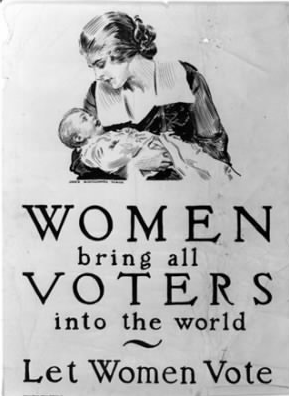Blog #5: Republican Motherhood.
Blog #5: Republican Motherhood.
- What role did the Revolutionary War play in the transformation of housewifery to Republican Motherhood? The Revolutionary War transformed housewifery to Republican Motherhood in the sense that women were now expected to nurture the future men of America. The domestic sphere, the household, is the "cradle of the human race" (Doc A) and women were held to the standard of raising men through "mental nourishment" (Doc C) and "training up good citizens" (Doc A). Also, the idea of female education was reformed to prepare women for their domestic duties. This outlines how the rising sense of patriotism and independence made women entitled to keeping order in society, since they were responsible for the future of America.
- What were the consequences of Republican Motherhood on women? In some aspects, Republican Motherhood made people realize the importance of women. Women were the ones who kept order in society. They were responsible for raising the men who shaped the future of America. On the other hand, women were restricted to the domestic sphere. If women "mingle in any great public movements... [they] [are] deserting the station which God and nature have assigned to her" (Doc A).
- What is the significance of the ideology of Republican Motherhood as a stage in the process of women’s socialization? Republican Motherhood is significant in the process of women's socialization because it developed an appreciation for the roles of women. Women had a vital place in society and "the destiny of our country" (Doc D) was in their hands. They determine the if the "beautiful order of society" (Doc D) will continue.

Mary Gibson Tilghman and her sons by Charles Willson Peale (1789)
1. Describe the setting. The setting of this portrait is in a room with a pink sofa. The family is sitting so that the two sons are on Mary's lap and they seem to belong to the upperclass because of their clothes, positions, and facial expressions.2. Who serves at the center of the portrait and why? How does the woman look? How is she “republican” rather than aristocratic? The woman, Mary Gibson Tilghman, is the center of the portrait to depict her stature in the household. Mary has power of the domestic sphere and therefore, has power over her sons. She is in the center to emphasize the importance of motherhood as a role in society. She looks calm, but happy. Also, she appears to be republican rather than aristocratic because while she is well dressed, her clothing is not overly extravagant and neither her hair or makeup is overdone.3. What values do her sons exhibit? Her sons are wearing dresses, showing their status in society. They are young, sitting calmly and are likely mature. Both of these are values that sons belonging to an upperclass household would exhibit therefore the sons, and family altogether, express a rather assertive mood to emphasize their upperclass status.4. Is there a significance to the position of Mrs. Tilgham’s arm? Mary's arm is rested on the lap of her son. This is significant because it is likely that her arm shows how her domestic duties have influenced her son. She is responsible for his future and nurturing him so he can be a part of society, so her arm is laying on him to show him how she will guide, nourish, and protect him.

Comments
Post a Comment